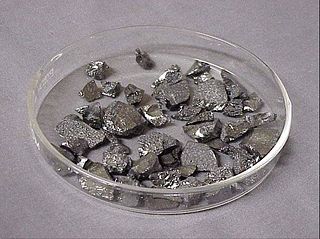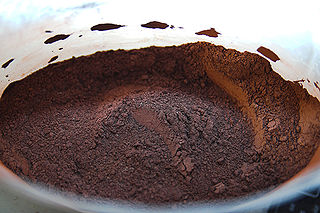Delay composition, also called delay charge or delay train, is a pyrotechnic composition, a sort of pyrotechnic initiator, a mixture of oxidizer and fuel that burns in a slow, constant rate that should not be significantly dependent on temperature and pressure. Delay compositions are used to introduce a delay into the firing train, e.g. to properly sequence firing of fireworks, to delay firing of ejection charges in e.g. model rockets, or to introduce a few seconds of time between triggering a hand grenade and its explosion. Typical delay times range between several milliseconds and several seconds.
A pyrotechnic composition is a substance or mixture of substances designed to produce an effect by heat, light, sound, gas/smoke or a combination of these, as a result of non-detonative self-sustaining exothermic chemical reactions. Pyrotechnic substances do not rely on oxygen from external sources to sustain the reaction.
A pyrotechnic initiator is a device containing a pyrotechnic composition used primarily to ignite other, more difficult-to-ignite materials, e.g. thermites, gas generators, and solid-fuel rockets. The name is often used also for the compositions themselves.

A fuel is any material that can be made to react with other substances so that it releases energy as heat energy or to be used for work. The concept was originally applied solely to those materials capable of releasing chemical energy but has since also been applied to other sources of heat energy such as nuclear energy.
A popular delay charge is a tube of pressed black powder. The mechanical assembly prevents the outright detonation of the charge.
While delay compositions are principally similar to other fuel-oxidizer compositions, larger grain sizes and less aggressively reacting chemicals are used. Many of the compositions generate little or no gas during burning. Typical materials used are:
- Fuels: silicon, boron, manganese, tungsten, antimony, antimony trisulfide, zirconium, zirconium – nickel alloy, zinc, magnesium, etc.
- Oxidizers: lead dioxide, iron oxides, barium chromate, lead chromate, tin(IV) oxide, bismuth(III) oxide, barium sulfate (for high-temperature compositions), potassium perchlorate (usually used in small amount together with other oxidizers), etc.
- Additives to cool down the flame and slow down the reaction can be employed; inert materials or coolants like titanium dioxide, ground glass, chalk, sodium bicarbonate, etc. are common.
Silicon is a chemical element with symbol Si and atomic number 14. It is a hard and brittle crystalline solid with a blue-grey metallic lustre; and it is a tetravalent metalloid and semiconductor. It is a member of group 14 in the periodic table: carbon is above it; and germanium, tin, and lead are below it. It is relatively unreactive. Because of its high chemical affinity for oxygen, it was not until 1823 that Jöns Jakob Berzelius was first able to prepare it and characterize it in pure form. Its melting and boiling points of 1414 °C and 3265 °C respectively are the second-highest among all the metalloids and nonmetals, being only surpassed by boron. Silicon is the eighth most common element in the universe by mass, but very rarely occurs as the pure element in the Earth's crust. It is most widely distributed in dusts, sands, planetoids, and planets as various forms of silicon dioxide (silica) or silicates. More than 90% of the Earth's crust is composed of silicate minerals, making silicon the second most abundant element in the Earth's crust after oxygen.

Boron is a chemical element with symbol B and atomic number 5. Produced entirely by cosmic ray spallation and supernovae and not by stellar nucleosynthesis, it is a low-abundance element in the Solar system and in the Earth's crust. Boron is concentrated on Earth by the water-solubility of its more common naturally occurring compounds, the borate minerals. These are mined industrially as evaporites, such as borax and kernite. The largest known boron deposits are in Turkey, the largest producer of boron minerals.

Manganese is a chemical element with symbol Mn and atomic number 25. It is not found as a free element in nature; it is often found in minerals in combination with iron. Manganese is a metal with important industrial metal alloy uses, particularly in stainless steels.
The burn rates are dependent on:
- nature of fuel - fuels that release more heat burn faster
- nature of oxidizer - oxidizers that require less heat to decompose burn faster
- the composition ratio - stoichiometric mixtures burn the fastest, also slight excess of metallic fuel also increases burn rate, probably due to heat transfer
- particle sizes - smaller particles burn faster, but too small particles may lead to incomplete or interrupted burn due to too narrow heating zone
- mechanical assembly and housing - charge diameter and thermal conductivity of housing influence lateral heat losses
- ambient temperature - ideally this dependence is very low but extremely low or extremely high temperatures may have influence
Examples of some compositions are:
- black powder with addition of inert material, e.g. chalk or sodium bicarbonate
- lead(II) oxide with silicon, burning at 1.5–2 cm/s
- red lead with silicon, burning at intermediate rate
- lead(IV) oxide with silicon, burning at 5–6 cm/s
- potassium permanganate with antimony, very slow
- Manganese Delay Composition: manganese with lead chromate and barium chromate (lead chromate is the principal oxidizer, barium chromate acts as burning rate modifier, the more of it the slower the reaction) [1]
- Tungsten Delay Composition: tungsten with barium chromate and potassium perchlorate [2]
- Zirconium Nickel Alloy Delay Composition: zirconium-nickel alloy with barium chromate and potassium perchlorate. [3]
- boron with barium chromate

Chalk is a soft, white, porous, sedimentary carbonate rock, a form of limestone composed of the mineral calcite. Calcite is an ionic salt called calcium carbonate or CaCO3. It forms under reasonably deep marine conditions from the gradual accumulation of minute calcite shells (coccoliths) shed from micro-organisms called coccolithophores. Flint (a type of chert) is very common as bands parallel to the bedding or as nodules embedded in chalk. It is probably derived from sponge spicules or other siliceous organisms as water is expelled upwards during compaction. Flint is often deposited around larger fossils such as Echinoidea which may be silicified (i.e. replaced molecule by molecule by flint).

Sodium bicarbonate (IUPAC name: sodium hydrogen carbonate), commonly known as baking soda, is a chemical compound with the formula NaHCO3. It is a salt composed of a sodium cation (Na+) and a bicarbonate anion (HCO3−). Sodium bicarbonate is a white solid that is crystalline, but often appears as a fine powder. It has a slightly salty, alkaline taste resembling that of washing soda (sodium carbonate). The natural mineral form is nahcolite. It is a component of the mineral natron and is found dissolved in many mineral springs.

Lead(II) oxide, also called lead monoxide, is the inorganic compound with the molecular formula PbO. PbO occurs in two polymorphs: litharge having a tetragonal crystal structure, and massicot having an orthorhombic crystal structure. Modern applications for PbO are mostly in lead-based industrial glass and industrial ceramics, including computer components. It is an amphoteric oxide.





